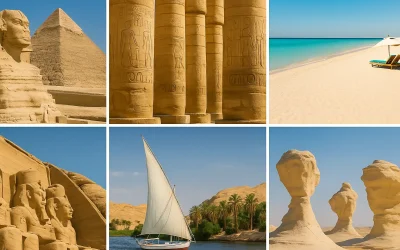Kharga Oasis: The Hidden Jewel of Egypt’s Western Desert
Kharga Oasis, the largest and most developed oasis in Egypt’s vast Western Desert, stands as a living testament to history, resilience, and breathtaking natural beauty. Unlike the bustling metropolises of the Nile Valley, Kharga offers a more serene yet equally fascinating window into Egypt’s ancient past. Nestled about 200 kilometers west of the Nile, this fertile depression has been a crucial crossroad for travelers, traders, and civilizations for thousands of years. It’s not just an oasis; it’s a treasure trove of archaeological wonders, timeless landscapes, and cultural narratives that weave together an enchanting story for every visitor. For those eager to peel back the layers of Egypt beyond the pyramids and temples, Kharga Oasis is a revelation.
The appeal of Kharga Oasis lies in its dual nature: it’s both a retreat and a historical archive. The endless stretches of golden sand that surround it are suddenly interrupted by lush palm groves, bubbling springs, and cultivated fields. What makes Kharga especially remarkable is its role in connecting ancient trade routes. For millennia, caravans traveling across the unforgiving Sahara rested here, exchanging goods, stories, and culture. This endless flow of people left behind a mosaic of ruins and monuments, from Roman fortresses to early Christian necropolises, making Kharga Oasis a paradise for history enthusiasts. Today, modern travelers can explore this oasis not only for its archaeological gems but also for its authentic desert experience—far from the crowded tourist circuits of Cairo and Luxor.
Whether you’re dreaming of wandering through ancient temples, marveling at Greco-Roman architecture, or simply soaking up the calm of desert life under a sky studded with stars, Kharga Oasis delivers. It’s an ideal destination for those craving depth and tranquility in their Egyptian adventure. With its unique combination of heritage, natural beauty, and cultural richness, Kharga Oasis deserves a spot on every traveler’s bucket list. If you’re planning your next holiday and want to uncover the hidden gems of Egypt, don’t miss the chance to descubre nuestros viajes a Egipto for curated journeys that bring this oasis and beyond to life.
Geographical Significance of Kharga Oasis
Kharga Oasis lies in a vast depression within Egypt’s Western Desert, stretching approximately 160 kilometers in length and 80 kilometers in width. Its strategic location has always made it a gateway between the Nile Valley and the Sahara. Unlike other oases that remain isolated, Kharga historically functioned as a vibrant hub where desert paths converged. With its natural springs, fertile lands, and protective geography, it has sustained human settlement for thousands of years.
The desert climate of Kharga is harsh, with blazing daytime heat and cool nights, yet its underground aquifers make life possible in this otherwise arid environment. Thanks to these subterranean water sources, large expanses of the oasis are green and cultivated. Date palms, olives, and various crops thrive here, offering not only sustenance but also commercial value for local communities. This delicate balance between harsh desert and fertile oasis is what makes Kharga a fascinating geographical phenomenon and a beacon for travelers.
Kharga’s Role in Ancient Trade Routes
For centuries, Kharga Oasis was an essential station on the Darb El-Arbain, or “Forty Days Road,” a caravan route stretching across Africa. This ancient trade route linked central Africa to Egypt, facilitating the movement of gold, ivory, spices, and slaves. The oasis offered caravans a safe haven amid the treacherous desert, ensuring survival with its fresh water and shaded groves. Archaeological evidence along this route shows Roman forts and way stations that guarded travelers and secured Egypt’s wealth.
Even today, remnants of these fortifications stand tall, telling the story of Kharga’s indispensable role in connecting distant lands. For modern visitors, walking in the footsteps of ancient traders provides a palpable connection to the rhythms of history. If this fascinates you, you might also want to learn more about Egypt’s broader mercantile and cultural crossroads, including fascinating cities such as Alejandría, where trade and knowledge once flourished.
Historical Landmarks and Monuments
Kharga Oasis is home to an extraordinary array of archaeological sites that span diverse eras of Egypt’s past. These monuments, sculpted in stone or carved into the desert hills, resonate with echoes of human creativity and devotion. From Pharaonic times to Christian settlements, the oasis holds a layered historical narrative that attracts both scholars and casual explorers.
The Temple of Hibis
The Temple of Hibis is the crown jewel of Kharga’s archaeological treasures. Dating back to the 6th century BCE, under the Persian occupation of Egypt, this temple stands as the largest and best-preserved structure in the oasis. Dedicated to the god Amun, the temple’s intricate reliefs and carvings depict scenes from both Egyptian mythology and Persian rule. What makes Hibis truly unique is its fusion of artistic influences, blending traditional Egyptian motifs with foreign elements introduced by the Persians.
Walking through its columned halls, visitors can marvel at inscriptions that have survived for millennia, offering a glimpse into the complex religious and political life of the time. The sheer detail of the artwork testifies to the skill of ancient artisans and the cultural significance of Kharga Oasis as a spiritual and political center.
El Bagawat Necropolis
Another iconic site within Kharga Oasis is the El Bagawat Necropolis, one of the earliest and best-preserved Christian cemeteries in the world. Dating back to the 3rd to 7th centuries CE, this sprawling complex houses over 260 mud-brick tombs. Inside, vivid frescoes and biblical scenes adorn the walls, offering a rare glimpse into early Christian art in Egypt. Themes from both the Old and New Testament are depicted, merging Coptic traditions with the lingering influence of Pharaonic and Greco-Roman styles.
El Bagawat not only holds historical significance but also spiritual resonance. It embodies the continuity of faith, migration, and resilience in Egypt’s desert communities. For history buffs, this necropolis is a must-visit destination, standing as a bridge between ancient Egypt’s pagan traditions and its Christian era.
Roman Fortresses and Desert Guardians
The Romans, recognizing the vitality of Kharga Oasis, constructed several fortresses to defend trade routes and control desert crossings. Among these, Qasr al-Ghueita and Qasr al-Zayyan stand as remarkable examples of Roman military architecture in Egypt. Built with mudbrick and stone, these forts once housed soldiers, storerooms, and chapels, ensuring stability in an otherwise perilous desert environment.
Exploring these forts gives a sense of the constant struggle for survival in the desert, balanced by the ingenuity of Roman engineering. The forts, though weathered, still reflect the grandeur and strategic mindset of an empire that valued Kharga Oasis as a linchpin in its dominion. Travelers seeking to deepen their understanding of Egyptian heritage might also find inspiration in the splendid arquitectura egipcia that continues to awe across the country.
Cultural Life and Traditions of Kharga Oasis
Kharga Oasis isn’t only about ruins and relics—it’s also a living community with unique traditions, social practices, and cultural heritage. The local population, primarily of desert Bedouin descent, has preserved customs that blend ancient practices with modern adaptations. Agriculture remains central to life in Kharga, with families tending to date palms, olives, and small-scale farming plots. Markets buzz with activity as locals trade produce, handicrafts, and goods.
Hospitality is a cornerstone of Kharga’s tradition. Visitors often remark on being welcomed warmly into homes or offered tea by locals. Storytelling around campfires, music infused with desert rhythms, and traditional crafts such as weaving bring the cultural tapestry of Kharga to life. For travelers eager to experience authentic Egyptian traditions, this oasis offers an intimate, slower-paced encounter far removed from the urban hustle of places like El Cairo.
Cuisine and Local Flavors
Food in Kharga Oasis reflects the practicality and creativity of desert life. Dishes often revolve around hearty staples such as lentils, bread, and dates. Traditional stews cooked slowly over coals bring families together, while refreshing drinks made from dates and herbs soothe the desert heat. Visitors will also find echoes of broader comida típica de Egipto, adapted to the resources available in this oasis.
Sharing a meal here isn’t just about nourishment—it’s about connection, culture, and continuity. Travelers often leave with not just full stomachs but also stories and friendships forged over simple, delicious food.
Nature and Adventure in Kharga Oasis
Beyond its historical and cultural appeal, Kharga Oasis is a haven for nature lovers and adventurers. The surrounding desert landscapes are breathtaking, with sweeping dunes, rocky plateaus, and surreal horizons that change color with the shifting sun. For those who crave adventure, camel treks, desert safaris, and starlit camping experiences make Kharga a playground of exploration.
Eco-tourism is also on the rise here, with travelers seeking sustainable ways to experience the desert without harming its fragile ecosystem. Spending a night under Kharga’s sky, with stars glittering brighter than in any city, is often described as a life-changing experience. To enrich your Egyptian adventure, you can learn more about our offers designed for explorers who love history, culture, and adventure in equal measure.
Best Time to Visit Kharga Oasis
The desert climate makes timing crucial for visiting Kharga Oasis. Summers can be blisteringly hot, with temperatures soaring above 40°C. For a comfortable and enriching experience, the best time to visit is between October and April, when daytime temperatures are milder, and nights are pleasantly cool. This period also aligns with Egypt’s peak tourist season, ensuring easier access to guided tours and excursions.
During winter months, exploring ancient ruins, walking through palm groves, and embarking on desert treks become far more enjoyable. The climate also enhances the experience of stargazing and camping, cementing winter and early spring as the prime seasons for discovering Kharga Oasis in all its glory. For detailed planning, check out the mejor época para viajar a Egipto and tailor your journey to perfection.
How to Reach Kharga Oasis
Reaching Kharga Oasis requires a bit of planning, but the journey itself is part of the adventure. The oasis is connected by road to major cities such as Luxor and Asyut. Travelers often combine visits to Kharga with nearby attractions in the Nile Valley, forming a fascinating itinerary that spans both fertile river lands and the enigmatic desert.
For those seeking efficiency, buses and organized tours operate from major Egyptian cities. Adventurers may prefer private transport or guided desert expeditions, offering flexibility and greater immersion. Whether you come for a day trip or a multi-day stay, the journey to Kharga is an unforgettable experience that cements its reputation as one of Egypt’s most rewarding hidden gems.
FAQs about Kharga Oasis
What is Kharga Oasis famous for?
Kharga Oasis is renowned for its unique blend of historical monuments, including the Temple of Hibis, the El Bagawat Necropolis, and Roman fortresses. It’s also famous for its lush greenery in the middle of the desert and its role as a major stop on ancient trade routes.
Is Kharga Oasis worth visiting for tourists?
Absolutely. Kharga Oasis offers a peaceful and authentic alternative to Egypt’s more crowded tourist destinations. Its combination of history, nature, and culture makes it an enriching stop for travelers who want to go beyond the typical pyramid visits.
When is the best time to visit Kharga Oasis?
The best time to visit is between October and April when the weather is mild and ideal for exploring ruins, enjoying desert safaris, and experiencing outdoor adventures without the oppressive summer heat.
How does Kharga Oasis compare to other Egyptian oases?
Kharga Oasis is larger and more developed than many others, such as Bahariya Oasis or Siwa Oasis. Its rich archaeological sites and strategic historical role make it especially significant, though each oasis has its own charm and uniqueness.
Can travelers stay overnight in Kharga Oasis?
Yes, accommodations range from simple guesthouses to more comfortable hotels. Camping under the desert stars is also a popular option for adventurous visitors. Staying overnight allows travelers to fully enjoy the tranquility and natural beauty of the oasis.


